It looks like you're using an Ad Blocker.
Please white-list or disable AboveTopSecret.com in your ad-blocking tool.
Thank you.
Some features of ATS will be disabled while you continue to use an ad-blocker.
share:
SheopleNation
reply to post by NewAgeMan
They can't be certain. It could be liquid methane like on Titan, one of Saturn's moons. ~$heopleNation
bump post - soon we'll find a rocky water world, surely it's an inevitability, but we don't want to get ahead of ourselves..
So you're saying that liquid methane would have the same density as water? Based on the previous post that's how i read what you're saying.
I can't wait for all the new instruments to come on line in the next 5-10 years.. then it's going to be planets galore, enough of a sample that we ought to be able to find another rocky water world.
NewAgeMan
So you're saying that liquid methane would have the same density as water? Based on the previous post that's how i read what you're saying.
No, I never mentioned anything about density. I don't know enough about liquid methane to make such a claim. ~$heopleNation
JadeStar
NewAgeMan
reply to post by CosmicDude
how can they be certain that it's a liquid water world?
Basically if you know the density of a planet then you can tell what it is mostly made up of because different materials have different densities.
So we know that some planets are mostly gas giants like Jupiter, others are mostly ice, some are mostly carbon, others are mostly silicate (like the Earth), and these particular ones as well as several others (GJ1214 b for example) are mostly water.
i thought they determined the mass, not the density..
Hah, Lisa Kaltenegger, she's held a little speech on exoplanets at the local planetarium not too long ago. She's very congenial and you can hear her
enthusiasm for her work, when she speaks.
Anyway, very interesting indeed, thanks for sharing.
Anyway, very interesting indeed, thanks for sharing.
NewAgeMan
JadeStar
NewAgeMan
reply to post by CosmicDude
how can they be certain that it's a liquid water world?
Basically if you know the density of a planet then you can tell what it is mostly made up of because different materials have different densities.
So we know that some planets are mostly gas giants like Jupiter, others are mostly ice, some are mostly carbon, others are mostly silicate (like the Earth), and these particular ones as well as several others (GJ1214 b for example) are mostly water.
i thought they determined the mass, not the density..
If you have mass and you have the radius of a planet you can find density.
It's complicated but not all that different from what you learned in science class:
D = Density
M = Mass
V = Volume
D = M / V
Density = Mass divided by Volume
The volume is inferred from the radius of the planet. Bigger planets like Jupiter have large radii. Smaller planets like the Earth have small radii. The radius of the planet can be found if a planet transits its star (a transit is when a planet passes between us and a star, kinda like an eclipse).
This transit which causes a dip in a chart of the light from the star can be measured. This measurement displayed as a chart of the light from a star vs time is called a lightcurve.
Deeper dips in the lightcurve indicate a larger radius than shallower dips.
All Kepler planets transit their stars. If they didn't then Kepler would not have detected them. So all Kepler planets have known radii.
Here are the lightcurves of the 5 planets of the Kepler 62 system.
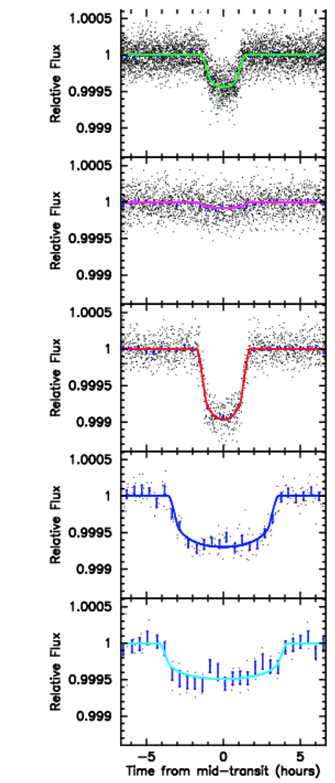
Here is the data on the 5 planets of the Kepler 62 system. The two water worlds are Kepler 62 e and Kepler 62 f
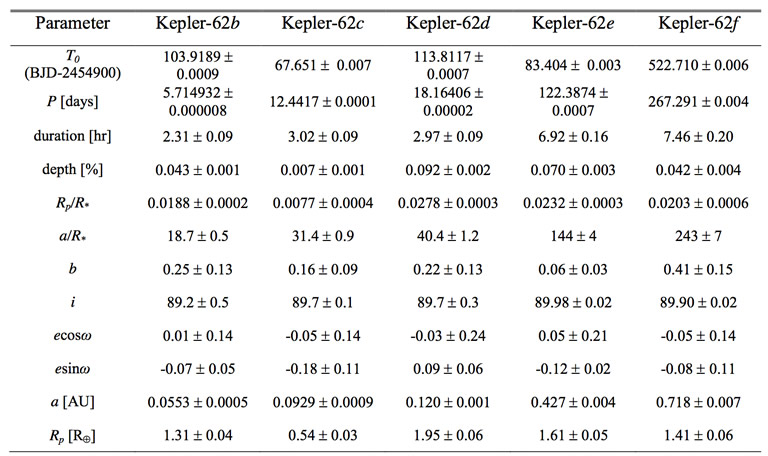
Rp with the symbol of the Earth = Earth Radii so for example the Kepler 62f has a measurement of 1.41 Rp which means its radius is 1.41 times that of Earth. So it's a just a little bigger than our world.
I hope this helps.
edit on 28-12-2013 by JadeStar because: (no reason given)
Marsupilami
Hah, Lisa Kaltenegger, she's held a little speech on exoplanets at the local planetarium not too long ago. She's very congenial and you can hear her enthusiasm for her work, when she speaks.
Anyway, very interesting indeed, thanks for sharing.
You'll find this is true of just about all exoplanet researchers. It's a labor of love. So many new discoveries raise new questions. It's a fertile ground of planetary science.
We're basically in a new age of discovery not unlike the age of Galileo and Copernicus when we first began learning details about the planets in our solar system. Now we're doing that for the Milky Way galaxy.
reply to post by JadeStar
How would they know if it's all or mostly water, based on mass and radii alone - couldn't there be variation in terms of it's core?
That was very helpful though, thanks.
How would they know if it's all or mostly water, based on mass and radii alone - couldn't there be variation in terms of it's core?
That was very helpful though, thanks.
NewAgeMan
reply to post by JadeStar
How would they know if it's all or mostly water, based on mass and radii alone - couldn't there be variation in terms of it's core?
That was very helpful though, thanks.
Ok....
This will be about the 4th time I've answered this.
Different materials have different molecular densities.
This is a chart of elemental densities but you get the point:
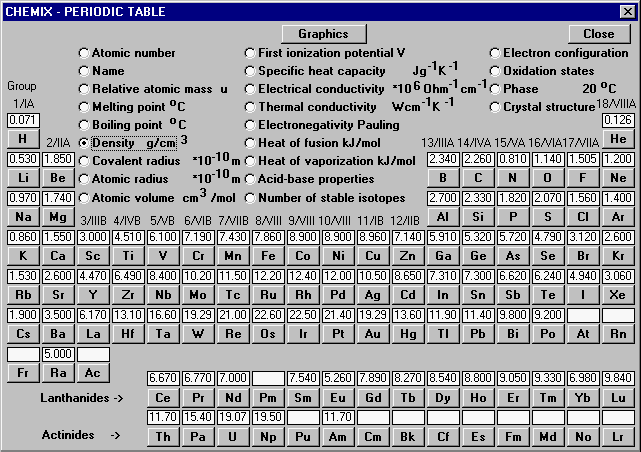
The Earth for example is mostly made up of Silicate/Sand (Si). It has a specific density that has been measured.
Jupiter is made up mostly of gasses Helium and Hydrogen (He and H). Likewise its density is different than that of Earth's as a result. That's why you've probably heard Jupiter would float in your bathtub, if say your bathtub were large enough to hold it.
Other exoplanets are made up mostly of carbon (C). One planet around Kepler 7 is made up mostly of Iron (Fe).
These planets as well as several others are found to be mostly made up of water based on having a molecular density of water (H2O).
The keyword is mostly.
In the case of these two planets they would be just about entirely made of water in order for its density to be what was measured.
As for a core. These planet's cores might consist of nothing but exotic ices (Ice 7, Ice 9, Ice 11 and so on.) Hot ices which exist at very high temperatures and very high pressures.
edit on 29-12-2013 by JadeStar because: (no reason given)
reply to post by JadeStar
Hot ices? Ice 7, ice 9, ice 11 - ice 13?
I don't understand. ice is cold, not hot, how can you have hot ice or a hot ice core?
Will we be expecting to find planets made mostly of each element on the periodic table?
Are there planets made of gold, of diamond?
Also, if Earth is the byproduct of a type of galactic evolutionary process, wouldn't it be most likely that we would find another earth circling a similar star in our own neighborhood of the galaxy?
Hot ices? Ice 7, ice 9, ice 11 - ice 13?
I don't understand. ice is cold, not hot, how can you have hot ice or a hot ice core?
Will we be expecting to find planets made mostly of each element on the periodic table?
Are there planets made of gold, of diamond?
Also, if Earth is the byproduct of a type of galactic evolutionary process, wouldn't it be most likely that we would find another earth circling a similar star in our own neighborhood of the galaxy?
NewAgeMan
reply to post by JadeStar
Hot ices? Ice 7, ice 9, ice 11 - ice 13?
I don't understand. ice is cold, not hot, how can you have hot ice or a hot ice core?
Hi again. I answered this here in this thread on page 3:
www.abovetopsecret.com...
Will we be expecting to find planets made mostly of each element on the periodic table?
Maybe not each of them but certainly different combinations of them certainly. It's diverse universe. However one should keep in mind certain elements are more common than others. Hydrogen and Helium are the most abundant elements in the universe. Carbon and Silicon are also very abundant. Gold, Titanium, Platinum, not so much.
This has to do with the process by which these elements are made in the cores of stars. Its harder for stars to make those rarer elements so less of them are made.
Are there planets made of gold, of diamond?
As far as we know there are no planets made up mostly of gold, though there is no reason why they couldn't exist in theory.
So I don't think anyone would tell you it's impossible for there to be a gold planet. Just improbable.
As for diamond, funny you should ask that.
The answer is YES! Diamond after all is formed by carbon under extreme pressure. And since carbon is very common in the universe it was only a matter of time before we found some planet with a lot of diamonds.
There is a planet, called 55 Cancri e, discovered in 2004, which is thought to be made mostly of carbon/diamond:
Space.com: Super-Earth Planet Likely Made of Diamond
Move over, Hope Diamond. The most famous gems on Earth have new competition in the form of a planet made largely of diamond, astronomers say.
The alien planet, a so-called "super-Earth," is called 55 Cancri e and was discovered in 2004 around a nearby star in our Milky Way galaxy. After estimating the planet's mass and radius, and studying its host star's composition, scientists now say the rocky world is composed mainly of carbon (in the form of diamond and graphite), as well as iron, silicon carbide, and potentially silicates.
At least a third of the planet's mass is likely pure diamond.
Suffice to say, THAT planet is a girl's best friend.
Also, if Earth is the byproduct of a type of galactic evolutionary process, wouldn't it be most likely that we would find another earth circling a similar star in our own neighborhood of the galaxy?
Yes. They have recently calculated the odds of that based on statistical data from Kepler and what is known about the nearby stars in our neighborhood of the galaxy.
The nearest Earthlike planet around a star like our Sun is likely to be around 12-14 light years away. The nearest Earthlike planet around a smaller red dwarf star is thought to be between 6.4 and 10 light years away. (94% accuracy)

edit on 29-12-2013 by JadeStar because: (no reason given)
One more chart for NewAgeMan and anyone else who might be wondering how we know these planets are mostly water.
This chart shows different exoplanet densities plotted by Mass and Radius.
You can see where Earth fits in as well:
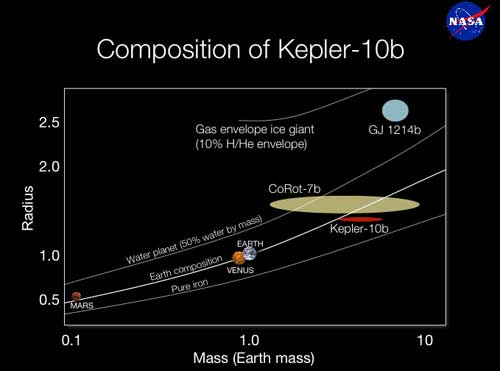
The black dot on the chart below is Kepler 78b which has a density almost identical to that of the Earth.
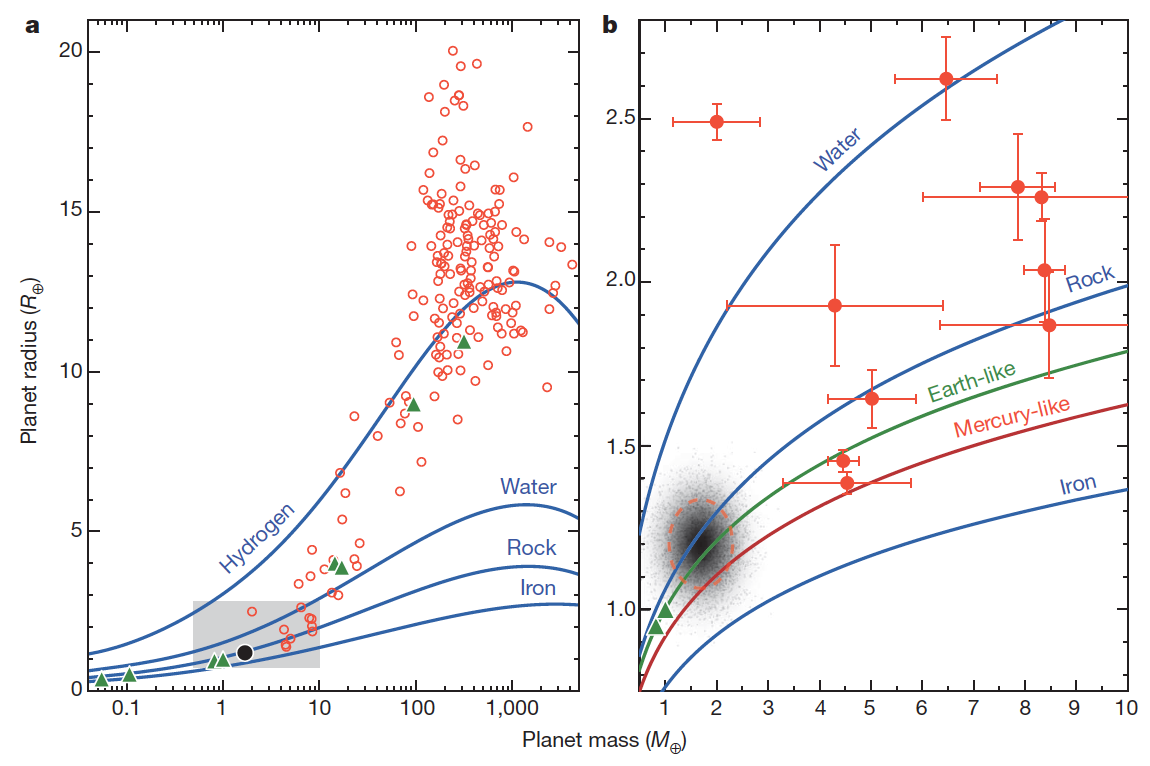
Sidenote: Most people think of the Earth as a water world but there is relatively little water on Earth compared to its total volume. Earth is a silicate planet. It's just that the water that is on Earth covers a large amount of surface area.
Here is what all the water on earth would look like if you could make a 3-D ball of it compared to the Earth.

So next time you're at the beach and you look at the ocean, know that the Earth is made mostly of the sand you're sitting on.
This chart shows different exoplanet densities plotted by Mass and Radius.
You can see where Earth fits in as well:

The black dot on the chart below is Kepler 78b which has a density almost identical to that of the Earth.

Sidenote: Most people think of the Earth as a water world but there is relatively little water on Earth compared to its total volume. Earth is a silicate planet. It's just that the water that is on Earth covers a large amount of surface area.
Here is what all the water on earth would look like if you could make a 3-D ball of it compared to the Earth.

So next time you're at the beach and you look at the ocean, know that the Earth is made mostly of the sand you're sitting on.
edit on
29-12-2013 by JadeStar because: (no reason given)
new topics
-
George Knapp AMA on DI
Area 51 and other Facilities: 1 hours ago -
Not Aliens but a Nazi Occult Inspired and then Science Rendered Design.
Aliens and UFOs: 1 hours ago -
Louisiana Lawmakers Seek to Limit Public Access to Government Records
Political Issues: 3 hours ago -
The Tories may be wiped out after the Election - Serves them Right
Regional Politics: 4 hours ago -
So I saw about 30 UFOs in formation last night.
Aliens and UFOs: 6 hours ago -
Do we live in a simulation similar to The Matrix 1999?
ATS Skunk Works: 7 hours ago -
BREAKING: O’Keefe Media Uncovers who is really running the White House
US Political Madness: 8 hours ago -
Biden--My Uncle Was Eaten By Cannibals
US Political Madness: 9 hours ago -
"We're All Hamas" Heard at Columbia University Protests
Social Issues and Civil Unrest: 9 hours ago -
The good, the Bad and the Ugly!
Diseases and Pandemics: 11 hours ago
top topics
-
BREAKING: O’Keefe Media Uncovers who is really running the White House
US Political Madness: 8 hours ago, 22 flags -
Biden--My Uncle Was Eaten By Cannibals
US Political Madness: 9 hours ago, 18 flags -
George Knapp AMA on DI
Area 51 and other Facilities: 1 hours ago, 15 flags -
African "Newcomers" Tell NYC They Don't Like the Free Food or Shelter They've Been Given
Social Issues and Civil Unrest: 14 hours ago, 12 flags -
Two Serious Crimes Committed by President JOE BIDEN that are Easy to Impeach Him For.
US Political Madness: 17 hours ago, 9 flags -
Russia Flooding
Fragile Earth: 15 hours ago, 7 flags -
"We're All Hamas" Heard at Columbia University Protests
Social Issues and Civil Unrest: 9 hours ago, 7 flags -
911 emergency lines are DOWN across multiple states
Breaking Alternative News: 17 hours ago, 7 flags -
Russian intelligence officer: explosions at defense factories in the USA and Wales may be sabotage
Weaponry: 13 hours ago, 5 flags -
So I saw about 30 UFOs in formation last night.
Aliens and UFOs: 6 hours ago, 5 flags
active topics
-
George Knapp AMA on DI
Area 51 and other Facilities • 7 • : NoCorruptionAllowed -
Not Aliens but a Nazi Occult Inspired and then Science Rendered Design.
Aliens and UFOs • 4 • : BernnieJGato -
Russia Flooding
Fragile Earth • 13 • : Maybenexttime -
911 emergency lines are DOWN across multiple states
Breaking Alternative News • 5 • : mysterioustranger -
Alabama Man Detonated Explosive Device Outside of the State Attorney General’s Office
Social Issues and Civil Unrest • 54 • : SomeStupidName -
Candidate TRUMP Now Has Crazy Judge JUAN MERCHAN After Him - The Stormy Daniels Hush-Money Case.
Political Conspiracies • 363 • : Annee -
"We're All Hamas" Heard at Columbia University Protests
Social Issues and Civil Unrest • 113 • : marg6043 -
The US Supreme Court Appears to Side With the January 6th 2021 Capitol Protestors.
Political Conspiracies • 47 • : EyeoftheHurricane -
British TV Presenter Refuses To Use Guest's Preferred Pronouns
Education and Media • 60 • : KrustyKrab -
Do we live in a simulation similar to The Matrix 1999?
ATS Skunk Works • 20 • : purplemer
